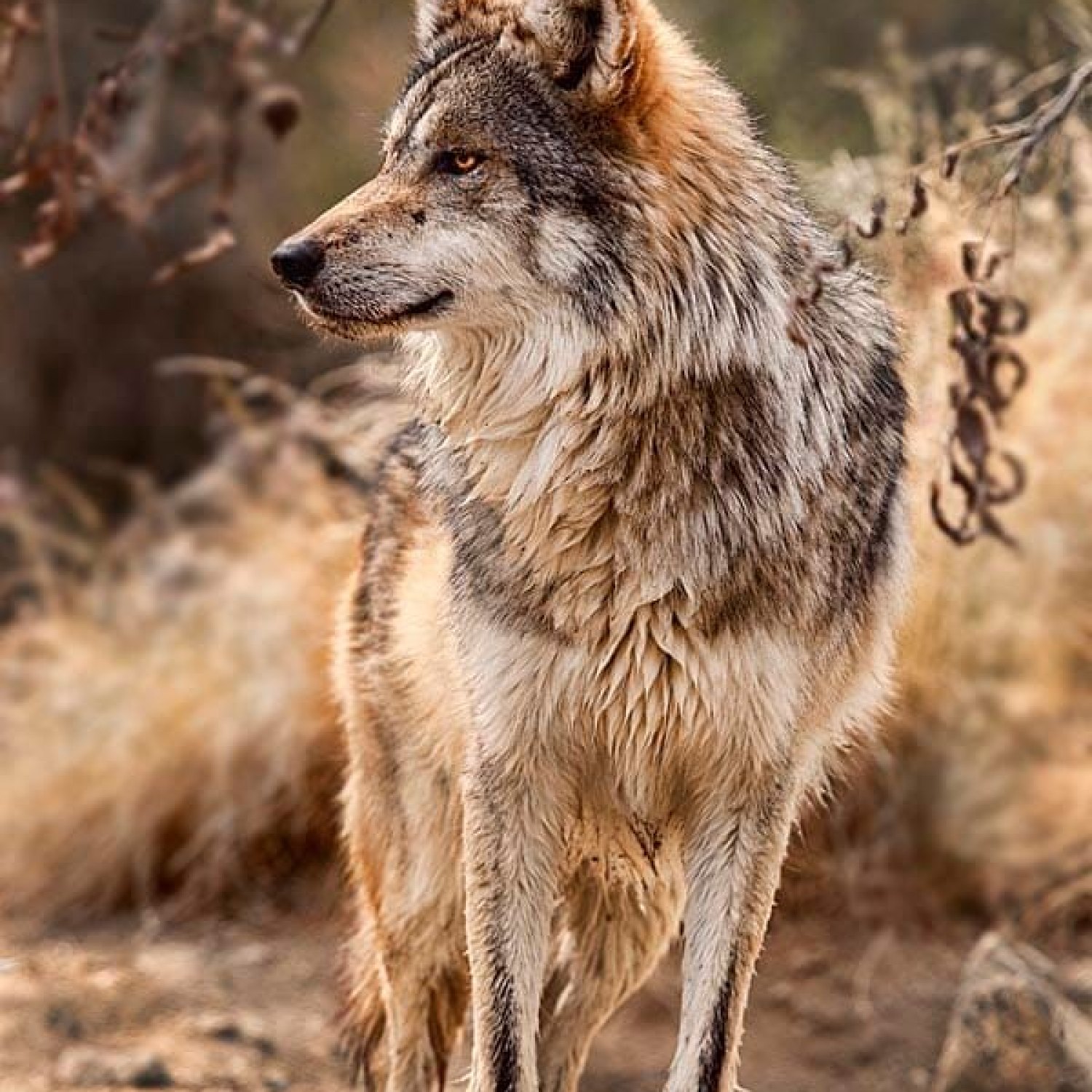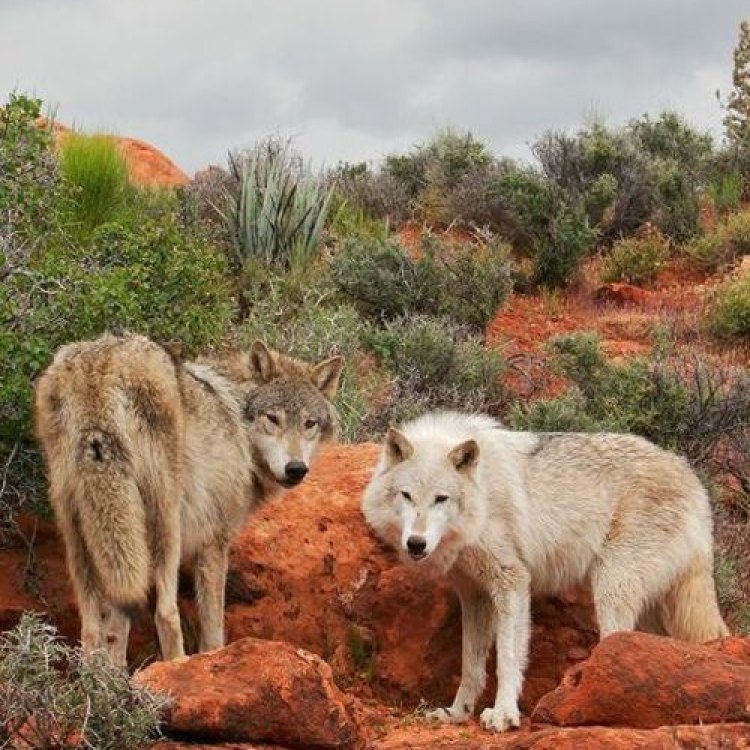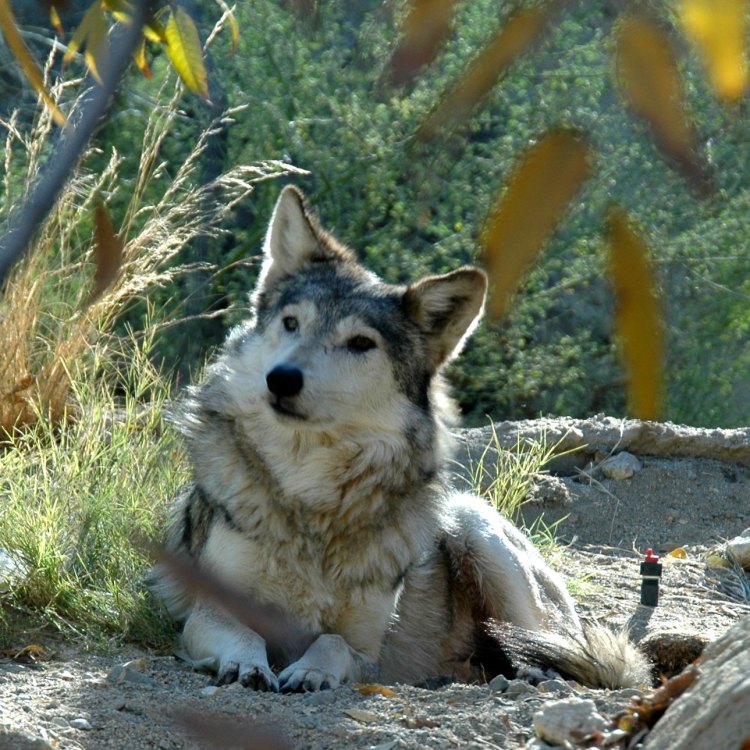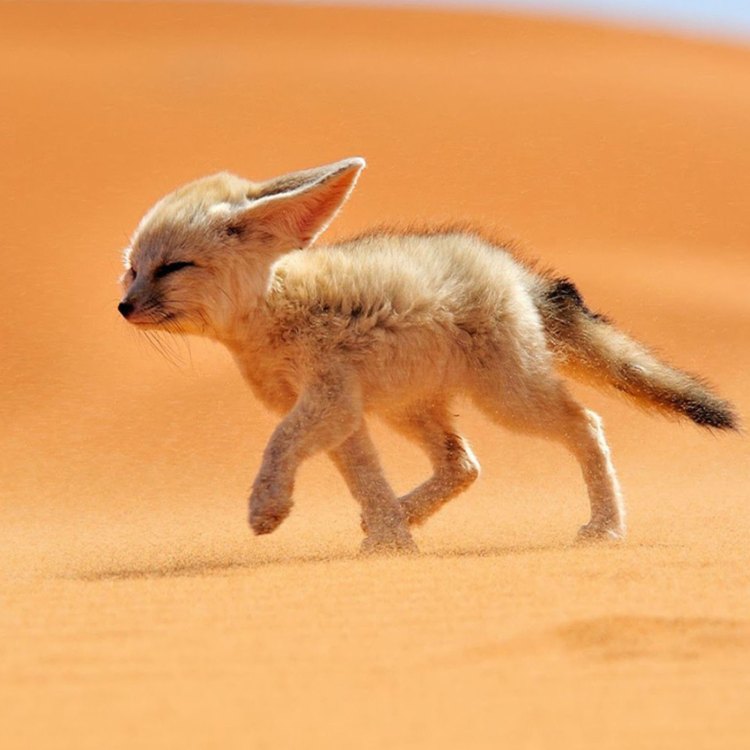
Desert Wolf
90-120 cm
The Desert Wolf, also known as the Arabian Wolf, is a medium-sized and slender canid found in the Sahara Desert and Arabian Peninsula. They can grow up to 90-120 cm in length and are a part of the Canidae family. These majestic animals are a vital part of their ecosystem and play an important role in maintaining balance and harmony in the desert environment. They also have a unique social structure and are skilled hunters, making them an intriguing species to learn about. #DesertWolf #ArabianWolf #SaharaDesert #Canidae #AnimalFacts
Animal Details Summary:
Common Name: Desert Wolf
Kingdom: Animalia
Habitat: Deserts, arid regions
The Elusive Desert Wolf: Adaptations for Survival in the Harsh Desert
The vast expanse of the Sahara Desert, with its unforgiving terrain and extreme temperatures, may seem like an inhospitable place for any creature to live. Yet, amidst the rolling dunes and scorching heat, the desert wolf thrives. Also known as Canis lupus arabs, this elusive and mysterious animal has developed unique adaptations that allow it to survive in one of the most hostile environments on Earth.The desert wolf, also called the Arabian wolf, belongs to the kingdom Animalia, phylum Chordata, and class Mammalia Desert Wolf. It is a member of the order Carnivora, and like its name suggests, is a carnivore. Its close relatives include the grey wolf, the coyote, and the domestic dog. However, unlike its cousins that mainly inhabit forested or grassland areas, the desert wolf has made the harsh desert landscape its home.
At first glance, the desert wolf may not seem like anything out of the ordinary. It has a medium-sized and slender body, measuring between 90-120 cm in length. Its coat is usually sandy or light brown in color, which helps it blend with its surroundings and remain camouflaged from potential predators or prey. But upon closer inspection, one can see the numerous adaptations that make this creature a master at surviving in the desert.
One key adaptation of the desert wolf is its exceptionally large ears. These ears help the animal to regulate its body temperature in the extreme desert heat Dhole. By constantly moving and adjusting its ears, the desert wolf dissipates heat and keeps its body cool. This also allows it to remain active throughout the day when most other animals retreat to the shade to avoid the scorching sun.
Another remarkable feature of the desert wolf is its large, splayed paws. These paws help the animal to navigate the loose sand and dunes of the desert with ease. The wolf's long toes prevent it from sinking into the sand, and the webbing between its toes provides greater surface area for traction and balance. This allows the desert wolf to move swiftly and efficiently across the desert terrain, whether it is chasing down prey or evading predators.
The desert wolf also has excellent eyesight, which enables it to spot potential prey from a distance. Its eyes are specially adapted to the bright sunlight and the shifting sands of the desert. Additionally, the wolf's elongated muzzle and sharp canines are ideal for hunting down its primary prey - small mammals such as rodents, hares, and birds. Its diet also includes insects, lizards, and any carrion it may come across in its vast territory.
Speaking of territory, the desert wolf roams over a large area, covering much of North Africa and the Middle East. Its geographical distribution ranges from Morocco in the west to the Arabian Peninsula in the east. However, the largest population of these elusive creatures can be found in their country of origin - Saudi Arabia. The vast and sparsely populated deserts of the Arabian Peninsula provide ample opportunity for the desert wolf to thrive, away from human interference.
Within the Arabian Peninsula, the desert wolf can be found roaming the vast expanse of the Sahara Desert. This hot and dry region, covering much of North Africa, is the largest hot desert in the world. With little vegetation and sparse water sources, the Sahara presents a formidable challenge for any animal to survive. Yet, the desert wolf has managed to find its place in this harsh environment, thanks to its remarkable adaptations.
One of the reasons why the desert wolf has been able to survive in the Sahara Desert is its feeding method. As a carnivore, it feeds solely on other animals, which are abundant in the desert. Being at the top of the food chain, the wolf has no natural predators. However, it does have to compete with other predators, such as the African wild dog and the striped hyena, for food and territory.
Despite its solitary nature, the desert wolf has developed a few techniques to communicate with other members of its species. Like other canids, it uses howls, barks, and body postures to alert other wolves of its presence. This is especially crucial during the breeding season, when the wolves come together to mate and raise their young. After a gestation period of 63 days, the female wolf gives birth to a litter of pups, usually between 4-6 in number. Together with its mate, the female raises and protects the pups, teaching them survival skills until they are old enough to go out on their own.
The elusive nature of the desert wolf and its preference for remote and inhospitable areas have made it challenging to study and monitor. As a result, there is little information available about the population numbers of these creatures. However, one thing is certain - the desert wolf's ability to adapt, survive, and thrive in the harsh desert environment is nothing short of remarkable.
In recent years, the desert wolf's habitat has come under threat due to human activities, such as livestock grazing and oil exploration. In some areas, the wolf is also considered a pest by local farmers, leading to intentional killing. These factors, combined with the desert's unpredictable and harsh climate, make the desert wolf's future uncertain.
In conclusion, the desert wolf, also known as the Arabian wolf, is a true desert survivor. From its large ears and splayed paws to its excellent eyesight and sharp canines, this fascinating animal has a range of unique adaptations that enable it to thrive in the extremely harsh and unforgiving environment of the Sahara Desert. As we continue to learn more about this elusive creature, it is our responsibility to protect its habitat and ensure its survival for future generations to come.

Desert Wolf
Animal Details Desert Wolf - Scientific Name: Canis lupus arabs
- Category: Animals D
- Scientific Name: Canis lupus arabs
- Common Name: Desert Wolf
- Kingdom: Animalia
- Phylum: Chordata
- Class: Mammalia
- Order: Carnivora
- Family: Canidae
- Habitat: Deserts, arid regions
- Feeding Method: Carnivore
- Geographical Distribution: North Africa, Middle East
- Country of Origin: Saudi Arabia
- Location: Sahara Desert, Arabian Peninsula
- Animal Coloration: Sandy or light brown
- Body Shape: Medium-sized and slender
- Length: 90-120 cm

Desert Wolf
- Adult Size: Medium
- Average Lifespan: 6-10 years
- Reproduction: Sexual
- Reproductive Behavior: Monogamous
- Sound or Call: Howling
- Migration Pattern: Non-migratory
- Social Groups: Solitary or small packs
- Behavior: Nocturnal and territorial
- Threats: Habitat loss, human disturbance
- Conservation Status: Least Concern
- Impact on Ecosystem: Predator
- Human Use: None
- Distinctive Features: Large ears, bushy tail
- Interesting Facts: Desert Wolves have adapted to survive in extreme desert conditions.
- Predator: Larger carnivores, such as hyenas and lions

Canis lupus arabs
The Unique and Mysterious Desert Wolf: Surviving in the Harsh Desert Conditions
In the dry, desolate landscapes of the desert, one can often imagine a barren wasteland with no signs of life. However, hidden within the grains of sand and howling winds, lies a creature that has mastered the art of survival in this seemingly inhospitable environment - the desert wolf.Desert Wolves, also known as the Arabian wolf or the gray wolf, are a subspecies of the gray wolf that have adapted to survive in the harsh conditions of the deserts in the Middle East and North Africa. They are medium-sized, standing at about 2 feet tall and weighing between 40-80 pounds at maturity PeaceOfAnimals.Com. Their average lifespan ranges from 6 to 10 years in the wild.
Unlike their larger relatives, the Arctic and Timber wolves, Desert wolves have smaller frames to help them conserve energy in the heat, making them more agile runners. However, what they lack in size, they make up for in their unique and fascinating features.
One of the most distinctive physical characteristics of Desert wolves is their large ears. These ears serve multiple purposes, one of which is to regulate their body temperature. As predators, they also use their keen hearing to locate prey from far distances and to decipher the sounds of the desert landscape.
Another unique attribute of the Desert wolf is their bushy tail, which they often hold up while running. This helps them maintain balance while navigating the desert terrain and also acts as a signaling mechanism when hunting or communicating with other pack members.
Speaking of communication, Desert wolves are known for their haunting and beautiful howls Desmostylus. Their howls can be heard up to 6 miles away, making it a vital form of vocalization for long-distance communication within the pack. This howling behavior also plays a significant role in territorial marking and maintaining a sense of togetherness within the pack.
Desert wolves are monogamous and form close-knit social groups with a dominant alpha pair and their offspring. They are primarily nocturnal creatures, using the cover of darkness to hunt and avoid the scorching heat of the day. However, they have been observed to also be active during the day, especially when temperatures are lower.
When it comes to reproduction, Desert wolves follow a monogamous system, meaning they mate with only one partner for life. This behavior allows them to maintain a stable social structure within the pack and ensure successful reproduction. Their reproductive cycle begins in early winter, with females giving birth to a litter of 4 to 6 pups in the spring.
However, despite their admirable abilities to thrive in the harsh desert environment, Desert wolves are still facing several threats. The most significant danger to their survival is habitat loss due to human development, such as oil extraction, livestock grazing, and urbanization. These activities not only strip away the wolves' essential food sources but also disrupt their social structure and breeding patterns.
Another human-induced threat to Desert wolves is disturbance from human activities, such as recreational activities like off-roading and hunting. This interference can cause the wolves to abandon their territories and disrupt their ability to hunt, leading to malnutrition and potential population decline.
Despite these threats, Desert wolves are currently listed as "Least Concern" on the International Union for Conservation of Nature (IUCN) Red List. This status is due to their relatively stable population and wide distribution across their range. However, with increasing human activities and habitat loss, their conservation status may change in the future.
One of the most critical roles that Desert wolves play in their ecosystem is that of a predator. As apex predators, they help maintain a balance in the desert food chain, preventing any one species from becoming too dominant. They primarily prey on smaller mammals, such as rodents, hares, and gazelles, but can also take down larger prey, including deer and domesticated animals like goats and sheep.
Despite their crucial role in the ecosystem, Desert wolves have had minimal human use. Unlike their gray wolf relatives, they have not been hunted or domesticated for human use. However, they are occasionally targeted by larger carnivores such as hyenas and lions, who see them as competition for food and territory.
Besides their unique physical and behavioral features, there are many interesting facts about the Desert wolf that make it a fascinating and mysterious creature. One of these facts is that they have adapted to survive on very little water, obtaining most of their hydration from the prey they consume. They also have a specialized sand-colored coat that helps them blend into their desert surroundings, making them a stealthy hunter.
Another survival adaptation that Desert wolves have developed is a webbing between their toes, allowing them to walk easily on sand and move quickly through the dunes. They also have a keen sense of smell, which they use to detect prey and predators from a distance.
In conclusion, the Desert wolf is a fascinating and unique creature that has adapted to survive in one of the most challenging environments in the world. From their large ears and bushy tails to their haunting howls and monogamous behavior, they are truly a marvel of evolution. However, their survival is gradually being threatened by human activities, highlighting the need for conservation efforts to protect and preserve these magnificent animals and their role in the delicate desert ecosystem.

The Elusive Desert Wolf: Adaptations for Survival in the Harsh Desert
Disclaimer: The content provided is for informational purposes only. We cannot guarantee the accuracy of the information on this page 100%. All information provided here may change without prior notice.












